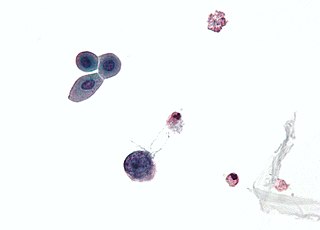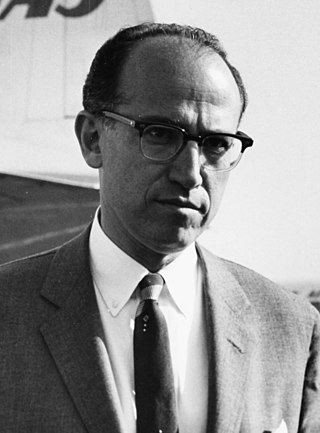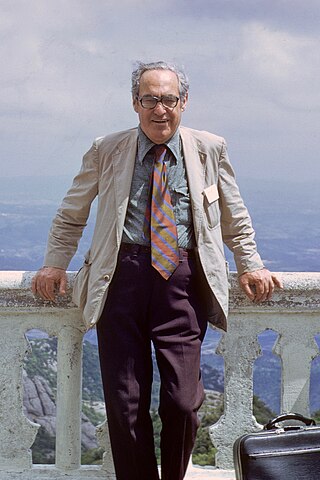Related Research Articles
Various fringe theories have arisen to speculate about purported alternative origins for the human immunodeficiency virus (HIV) and the acquired immunodeficiency syndrome (AIDS), with claims ranging from it being due to accidental exposure to supposedly purposeful acts. Several inquiries and investigations have been carried out as a result, and each of these theories has consequently been determined to be based on unfounded and/or false information. HIV has been shown to have evolved from or be closely related to the simian immunodeficiency virus (SIV) in West Central Africa sometime in the early 20th century. HIV was discovered in the 1980s by the French scientist Luc Montagnier. Before the 1980s, HIV was an unknown deadly disease.

Polio vaccines are vaccines used to prevent poliomyelitis (polio). Two types are used: an inactivated poliovirus given by injection (IPV) and a weakened poliovirus given by mouth (OPV). The World Health Organization (WHO) recommends all children be fully vaccinated against polio. The two vaccines have eliminated polio from most of the world, and reduced the number of cases reported each year from an estimated 350,000 in 1988 to 33 in 2018.

HeLa is an immortalized cell line used in scientific research. It is the oldest human cell line and one of the most commonly used. HeLa cells are durable and prolific, allowing for extensive applications in scientific study. The line is derived from cervical cancer cells taken on 8 February 1951, from Henrietta Lacks, a 31-year-old African American mother of five, after whom the line is named. Lacks died of cancer on 4 October 1951.

Polyomaviridae is a family of viruses whose natural hosts are primarily mammals and birds. As of 2020, there are six recognized genera and 117 species, five of which are unassigned to a genus. 14 species are known to infect humans, while others, such as Simian Virus 40, have been identified in humans to a lesser extent. Most of these viruses are very common and typically asymptomatic in most human populations studied. BK virus is associated with nephropathy in renal transplant and non-renal solid organ transplant patients, JC virus with progressive multifocal leukoencephalopathy, and Merkel cell virus with Merkel cell cancer.
SV40 is an abbreviation for simian vacuolating virus 40 or simian virus 40, a polyomavirus that is found in both monkeys and humans. Like other polyomaviruses, SV40 is a DNA virus that sometimes causes tumors in animals, but most often persists as a latent infection. SV40 has been widely studied as a model eukaryotic virus, leading to many early discoveries in eukaryotic DNA replication and transcription.
The oral polio vaccine (OPV) AIDS hypothesis is a now-discredited hypothesis that the AIDS pandemic originated from live polio vaccines prepared in chimpanzee tissue cultures, accidentally contaminated with simian immunodeficiency virus and then administered to up to one million Africans between 1957 and 1960 in experimental mass vaccination campaigns.

Albert Bruce Sabin was a Polish-American medical researcher, best known for developing the oral polio vaccine, which has played a key role in nearly eradicating the disease. In 1969–72, he served as the president of the Weizmann Institute of Science in Israel.

Hilary Koprowski was a Polish virologist and immunologist active in the United States who demonstrated the world's first effective live polio vaccine. He authored or co-authored over 875 scientific papers and co-edited several scientific journals.

Herald Rea Cox (1907–1986) was an American bacteriologist. The bacterial family Coxiellaceae and the genus Coxiella, which include the organism that causes Q fever, are named after him.

An oncovirus or oncogenic virus is a virus that can cause cancer. This term originated from studies of acutely transforming retroviruses in the 1950–60s, when the term "oncornaviruses" was used to denote their RNA virus origin. With the letters "RNA" removed, it now refers to any virus with a DNA or RNA genome causing cancer and is synonymous with "tumor virus" or "cancer virus". The vast majority of human and animal viruses do not cause cancer, probably because of longstanding co-evolution between the virus and its host. Oncoviruses have been important not only in epidemiology, but also in investigations of cell cycle control mechanisms such as the retinoblastoma protein.

Maurice Ralph Hilleman was a leading American microbiologist who specialized in vaccinology and developed over 40 vaccines, an unparalleled record of productivity. According to one estimate, his vaccines save nearly eight million lives each year. He has been described as one of the most influential vaccinologists ever. He has been called the "father of modern vaccines". Robert Gallo called Hilleman "the most successful vaccinologist in history". He has been noted by some researchers as having saved more lives than any other scientist in the 20th century.

The schedule for childhood immunizations in the United States is published by the Centers for Disease Control and Prevention (CDC). The vaccination schedule is broken down by age: birth to six years of age, seven to eighteen, and adults nineteen and older. Childhood immunizations are key in preventing diseases with epidemic potential.
Cutter Laboratories was a family-owned pharmaceutical company located in Berkeley, California, founded by Edward Ahern Cutter in 1897. Cutter's early products included anthrax vaccine, hog cholera virus, and anti-hog cholera serum—and eventually a hog cholera vaccine. The hog cholera vaccine was the first tissue culture vaccine, human or veterinary, ever produced. The company expanded considerably during World War II as a consequence of government contracts for blood plasma and penicillin. After Edward Cutter's death, his three sons—Dr. Robert K. Cutter (president), Edward "Ted" A. Cutter Jr. (vice-president), and Frederick A. Cutter—ran the company. In the next generation Robert's son David followed his father as president of the company. The Bayer pharmaceutical company bought Cutter Laboratories in 1974.
The SV40 Cancer Foundation is an educational organization devoted to raising awareness about a potential link between the simian virus SV40 and human cancer.

Isabel Merrick Morgan was an American virologist at Johns Hopkins University, who prepared an experimental vaccine that protected monkeys against polio in a research team with David Bodian and Howard A. Howe. Their research led to the identification of three distinct serotypes of poliovirus, all of which must be incorporated for a vaccine to provide complete immunity from poliomyelitis. Morgan was the first to successfully use a killed-virus for polio inoculation in monkeys. After she married in 1949, she left the field of polio research in part because she was uncomfortable with trials that tested polio vaccines on the nerve tissue of children. She then worked on epidemiological studies on air pollution. Later in life, she was a consultant for studies of cancer therapies at the Sloan-Kettering Cancer Institute.

Jonas Edward Salk was an American virologist and medical researcher who developed one of the first successful polio vaccines. He was born in New York City and attended the City College of New York and New York University School of Medicine.

Herbert Spencer Ratner, was an American physician. He taught and wrote on the philosophy and history of medicine and was a popular lecturer on marriage and the family. Ratner was the director of public health for the community of Oak Park, Illinois, for twenty-five years. An advocate of preventive family medicine based on natural norms, he was also a long-time proponent of informed medical consent, and played a pivotal role in the polio vaccine controversy beginning in 1955. For more than twenty-nine years Ratner was editor of Child and Family Quarterly, a paramedical journal which ran articles on the Hippocratic Oath, infant development, women’s health, and other topics related to family health.

Bernice Eddy was an American virologist and epidemiologist. She and Sarah Elizabeth Stewart are known for their discoveries related to polyomavirus, particularly SV40 polyomavirus.
Janet S Butel is the Chairman and Distinguished Service Professor in the molecular virology and microbiology department at Baylor College of Medicine. Her area of expertise is on polyomavirus pathogenesis of infections and disease. She has more than 120 publications on PubMed. She also has 6 publications in Nature, which is considered one of the most prestigious science journals. She is a member of 9 different organizations and has 13 honors and awards.

The announcement of the polio vaccine's safety and effectiveness was on April 12, 1955, by Thomas Francis, Jr., of the University of Michigan, the monitor of the test results. Within minutes of his announcement to the audience of scientists and reporters, news of the event was carried coast to coast by wire services and radio and television newscasts. When the vaccine was announced as successful, therefore, it led to spontaneous celebrations across the United States. It was the world's first successful polio vaccine, declared "safe, effective, and potent." It was possibly the most significant biomedical advance of the past century.
References
- ↑ Schipani, Vanessa (24 Apr 2018). "Did the Polio Vaccine Cause Cancer?". Factcheck.org. Retrieved 4 Mar 2020.
- ↑ "Historical Safety Concerns | Vaccine Safety | CDC". www.cdc.gov. 2022-03-30. Retrieved 2023-02-23.
- ↑ Grady, Denise (2002-10-23). "Study Is Unsure on Tainted Polio Vaccine's Cancer Role". The New York Times. ISSN 0362-4331 . Retrieved 2023-02-23.
- ↑ Ferber, Dan (2002). "Virology. Monkey virus link to cancer grows stronger". Science . 296 (5570): 1012–1015. doi:10.1126/science.296.5570.1012. PMID 12004103. S2CID 32723346.
- ↑ Bookchin, Debbie; Schumacher, Jim (2004). The Virus and the Vaccine . St. Martin's Press. pp. 226–28. ISBN 978-0-312-27872-4.
- ↑ Rizzo, Paola; Di Resta, Ilaria; Powers, Amy; Ratner, Herbert; Carbone, Michele (1999). "Unique Strains of SV40 in Commercial Poliovaccines from 1955 Not Readily Identifiable with Current Testing for SV40 Infection". Cancer Research. 59 (24): 6103–8. PMID 10626798.
- ↑ Martini, F; Corallini, A; Balatti, V; Sabbioni, S; Pancaldi, C; Tognon, M (9 July 2007). "Simian virus 40 in humans". Infectious Agents and Cancer. 2: 13. doi: 10.1186/1750-9378-2-13 . PMC 1941725 . PMID 17620119.
- ↑ Bookchin, Debbie (7 July 2004). "Vaccine scandal revives cancer fear". New Scientist .
- ↑ NIH/National Cancer Institute (2004-08-25). "Studies Find No Evidence That Simian Virus 40 Is Related To Human Cancer". Science Daily.
- ↑ Hilleman MR (1998). "Discovery of simian virus 40 (SV40) and its relationship to poliomyelitis virus vaccines". Dev Biol Stand. 94: 183–90. PMID 9776239.
- ↑ Carroll-Pankhurst, C; Engels, EA; Strickler, HD; Goedert, JJ; Wagner, J; Mortimer EA Jr. (November 2001). "Thirty-five year mortality following receipt of SV40- contaminated polio vaccine during the neonatal period". Br J Cancer. 85 (9): 1295–7. doi:10.1054/bjoc.2001.2065. PMC 2375249 . PMID 11720463.